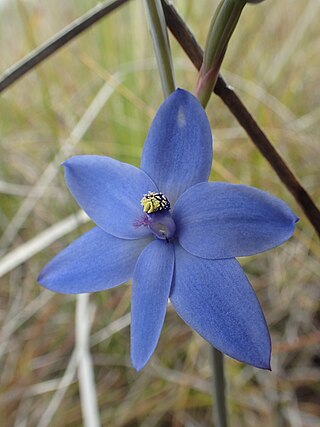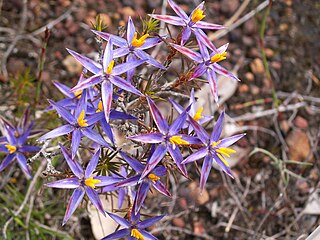
Calectasia is a genus of about fifteen species of flowering plants in the family Dasypogonaceae and is endemic to south-western Australia. Plants is this genus are small, erect shrubs with branched stems covered by leaf sheaths. The flowers are star-shaped, lilac-blue to purple and arranged singly on the ends of short branchlets.

Thelymitra crinita, commonly known as the blue lady orchid, queen orchid or lily orchid, is a species of orchid which is endemic to the south-west of Western Australia. It has a single broad, oval leaf and up to fifteen brilliant blue flowers with a blue column with the lobe on top of the anther covered with short, finger-like calli.
Melaleuca keigheryi is a shrub in the myrtle family, Myrtaceae with white, papery bark and is endemic to the west coast of Western Australia. In spring, it has heads of pink flowers which fade in color to become white.

Calectasia intermedia, commonly known as blue tinsel-lily or eastern tinsel lily is a species of flowering plant in the family Dasypogonaceae, endemic to the border areas of western Victoria and south-eastern South Australia and flowering in early spring. It is the only member of the genus Calectasia that is not endemic to Western Australia.

Calectasia grandiflora, commonly known as the blue tinsel lily, is a plant in the family Dasypogonaceae growing as a perennial herb endemic to the south-west of Western Australia. It flowers in spring.

Calectasia cyanea, commonly known as the star of Bethlehem or blue tinsel lily, is a plant in the family Dasypogonaceae growing as a perennial herb and is endemic to the south–west of Western Australia. Restricted to a single population in Torndirrup National Park, it is critically endangered.
Calectasia browneana, commonly known as blue tinsel lily, is a plant in the family Dasypogonaceae growing as a spreading, perennial, tufted herb. It is an uncommon species, endemic and restricted to a few areas in the south-west of Western Australia. It is similar to the other species of Calectasia and has only been recognised as a separate species since a review of the genus in 2001. It is distinguished from the others mainly by the hairiness of its leaves and lack of a rhizome.

Calectasia gracilis, commonly known as blue tinsel lily, is a plant in the family Dasypogonaceae and is endemic to the south-west of Western Australia. It is a spreading, tufted, woody, perennial herb with blue petals and six yellow stamens that turn orange-red as they age. It is similar to the other species of Calectasia and has only been recognised as a separate species since a review of the genus in 2001.

Calectasia hispida, commonly known as blue tinsel lily or hispid tinsel lily, is a plant in the family Dasypogonaceae growing as a rhizomatous, erect, clumping perennial herb. It is endemic to the south-west of Western Australia and is common in most of its range. It is similar to the other species of Calectasia and is distinguished from them mainly by the hairiness of its leaves and the glabrousness of the throat of the flowers.

Calectasia narragara, commonly known as a blue tinsel lily or star of Bethlehem, is a plant in the family Dasypogonaceae growing as a tufted rhizomatous herb. It is endemic to the southwest of Western Australia and common in most of its range.
Calectasia pignattiana, commonly known as the stilted tinsel lily or Pignatti's star of Bethlehem, is a plant in the family Dasypogonaceae growing as a perennial herb and is endemic to the south–west of Western Australia. It is only known from ten locations, four of which are on road verges. The species is classified as vulnerable.

Calectasia obtusa, commonly known as a blue tinsel lily or blunt-leaved tinsel lily is a plant in the family Dasypogonaceae growing as an erect, small shrub with stems to 50 cm. It is endemic to the south-west of Western Australia, widespread in most of its range but only known from nine populations.
Calectasia palustris, commonly known as a blue tinsel lily or swamp tinsel lily is a plant in the family Dasypogonaceae growing as a perennial, tufted herb with stilt roots. It is an uncommon species, endemic and restricted to a few areas in the south-west of Western Australia. It is similar to the other species of Calectasia and has only been recognised as a separate species since a review of the genus in 2001.
Eremophila praecox is a flowering plant in the figwort family, Scrophulariaceae and is endemic to Australia. It is a small, broom-like shrub with small leaves and purple and white flowers.

Eremophila veronica, commonly known as veronica-like eremophila, is a flowering plant in the figwort family, Scrophulariaceae and is endemic to Western Australia. It is a low, spreading shrub with small, crowded leaves and lilac-coloured flowers which have a short petal tube and spreading petal lobes.
Eremophila buirchellii is a flowering plant in the figwort family, Scrophulariaceae and is endemic to the Mount Augustus National Park in Western Australia. It is an erect shrub with densely clustered leaves, pink, bell-shaped flowers and with most parts of the plant covered with greyish, branched hairs.
Dasymalla chorisepala is a flowering plant in the mint family Lamiaceae and is endemic to Western Australia and the Northern Territory. It is a small shrub with its branches and leaves densely covered with hairs. The leaves are stalkless, egg-shaped and covered with yellowish hairs while the flowers are small, tube-shaped and white.
Calectasia Conservation Park, formerly the Calectasia National Parks Reserve, is a protected area located in the Australian state of South Australia in the locality of Wattle Range about 320 kilometres (200 mi) south-east of the state capital of Adelaide and about 25 kilometres (16 mi) west of the town of Penola.

Pityrodia obliqua is a flowering plant in the mint family Lamiaceae and is endemic to the Kimberley region of Western Australia. It is an erect shrub with hairy stems, wrinkled, egg-shaped leaves and pink, bell-like flowers with purple streaks inside.
Boronia thedae, commonly known as the Theda boronia, is a plant in the citrus family, Rutaceae and is endemic to a small area in the Kimberley region of Western Australia. It is an erect shrub when young, later a prostrate shrub with many branches, pinnate leaves, four white to cream-coloured or pale pink sepals and four similarly coloured petals, the sepals longer and wider than the petals.










